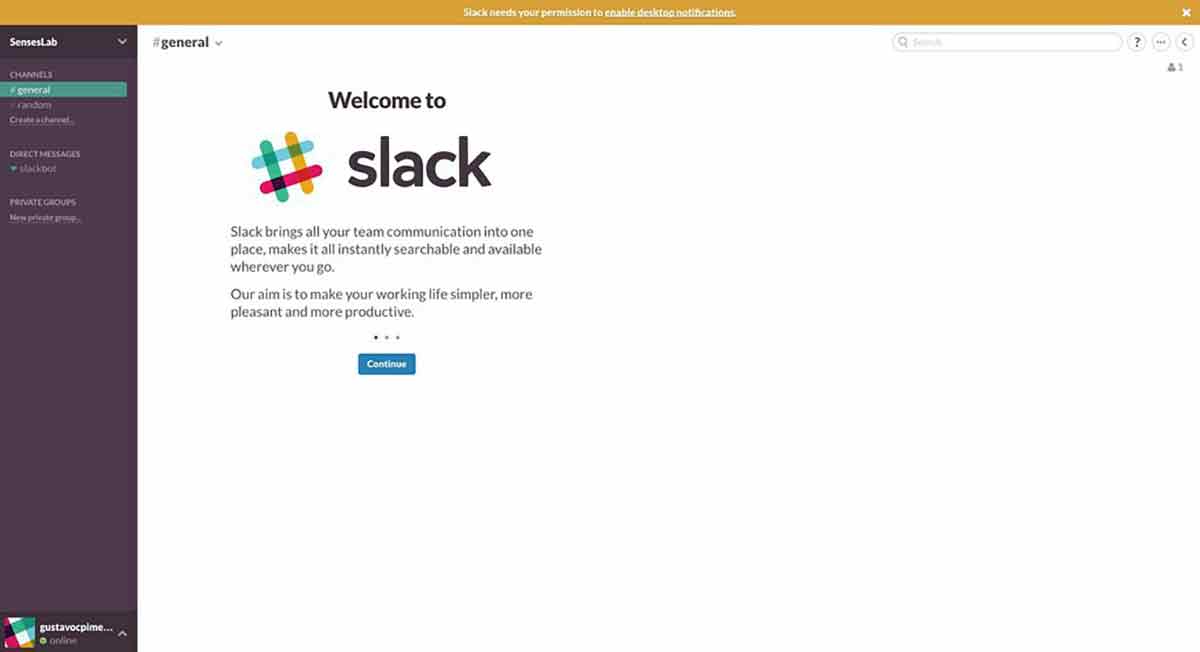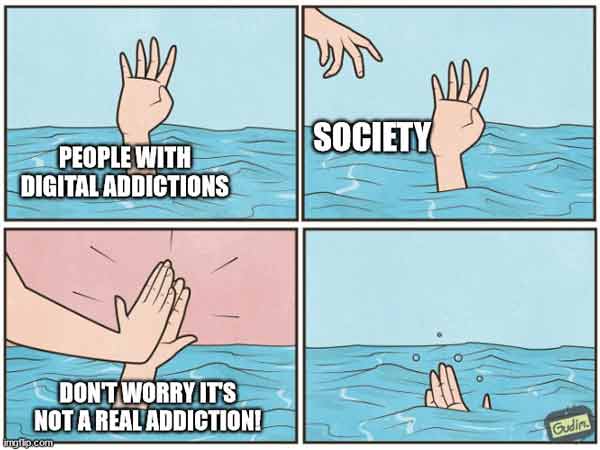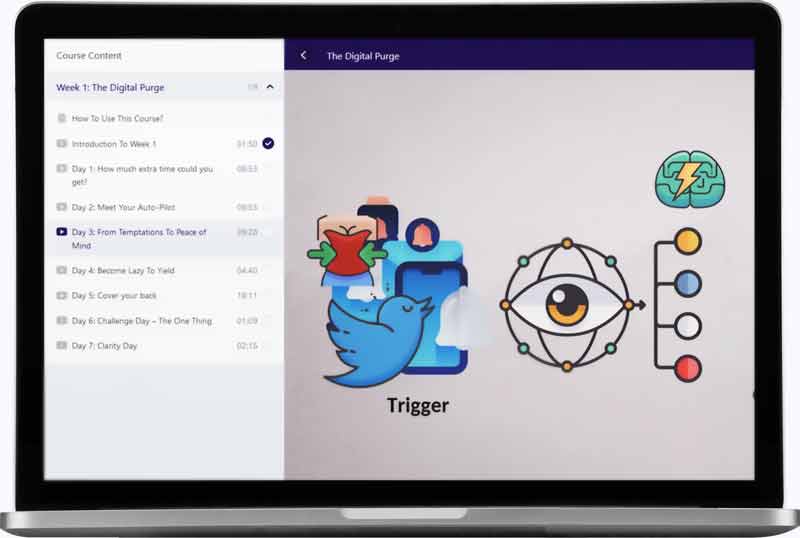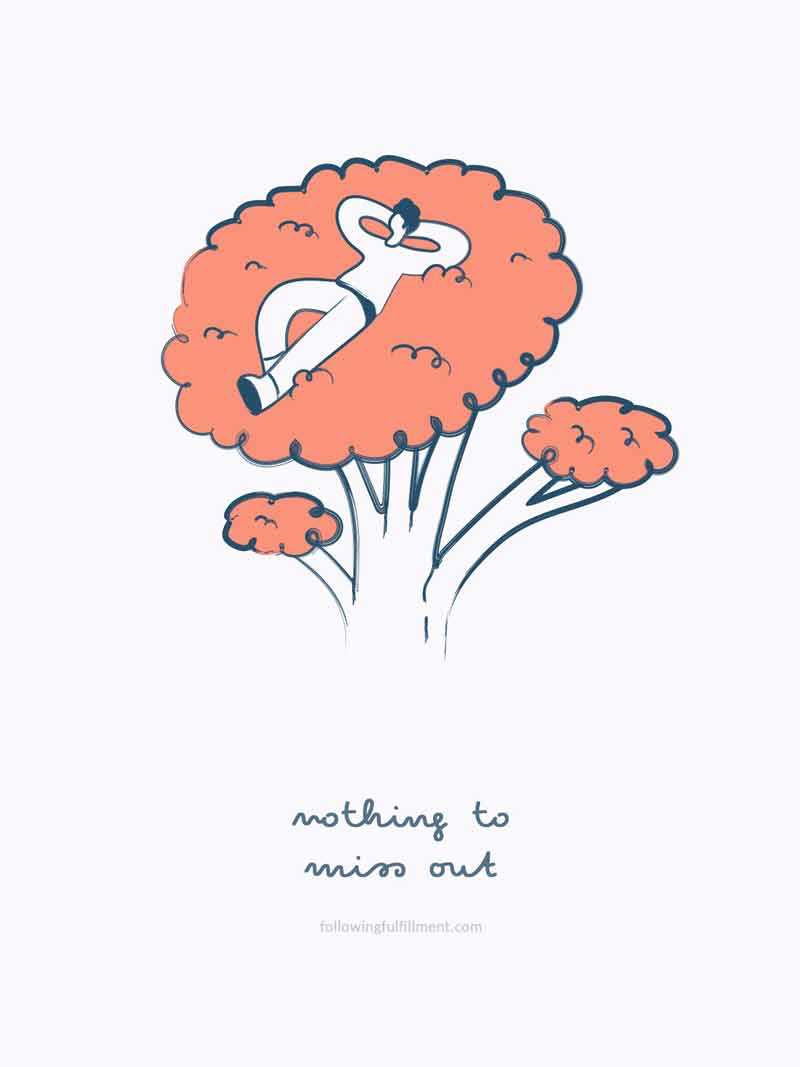Welcome to our digital detoxing series! A series on how to stop addictions to Fortnite,Facebook,Instagram,porn,Netflix, Youtube,Tinder… Find all the posts about digital addiction. Today, let’s talk about how to quit the slack addiction.

- What’s the slack addiction?
- Addiction to slack, a “real” addiction?
- What’s considered slack addiction
- How much slack is too much?
- Some work and productivity addiction facts & statistics
- Symptoms & Causes of the slack addiction
- Why is slack so addictive?
- Possible causes of slack dependency
- Symptoms, Causes and Signs of slack addiction
- Problems, impacts & bad effects of slack
- Some benefits of slack
- health problems
- impact on brain & mental health
- impact on relationships
- How to stop & quit your slack addiction
- Main steps and solutions to break the slack addiction
- Best slack blocker apps & functionalities
- where to seek extra help?
- Conclusion
- To Go Further
- How to help someone with slack addiction
- Best books about work and productivity addiction
- Research about work and productivity addiction
What is the slack addiction?
About slack
Slack is a messaging platform for teams to communicate, share files and manage tasks.
Addiction to slack, a “real” addiction?
Officially an addiction?
First, let’s have a look to the DSM-5,the Diagnostic and Statistical Manual of Mental Disorders. Does it includes slack addiction?
No, slack addiction is not listed in the DSM-5.
So what means “slack addiction”?
Slack addiction is a term used to describe an unhealthy reliance on the popular business communication platform Slack. It is often characterized by feelings of anxiety when not using Slack and the inability to focus on tasks or take a break from the platform. This type of addiction can have a negative impact on productivity and relationships.
What is considered slack addiction?
- 1. Spends a disproportionate amount of time on Slack compared to other activities.
- 2. Is unproductive or distracted in other areas of life because of excessive use of Slack.
- 3. Experiences withdrawal symptoms when not using Slack,such as irritability, restlessness, or anxiety.
- 4. Tries to hide or minimize the amount of time spent on Slack.
- 5. Uses Slack to cope with negative emotions or to escape from reality.
- 6. Ignores responsibilities or obligations in order to use Slack.
- 7. Has difficulty reducing or quitting the use of Slack despite wanting to do so.
- 8. Develops a tolerance for Slack,needing more and more time to feel satisfied.
How much slack is too much?
The amount of time spent on Slack is ultimately up to you and depends on your needs. However, if you find that you’re spending too much time on it and it’s taking away from other important tasks, it may be time to limit your usage or find an alternative.
Some work and productivity addiction facts & statistics

According to studies, work and productivity addiction, also known as workaholism, is a growing concern in many countries. Here are some statistics related to work and productivity addiction:
- 1. In a survey of 1,000 employees, 25% reported feeling addicted to work.
- 2. A study found that workaholism is associated with a higher risk of physical and mental health problems,including anxiety, depression, and sleep disorders.
- 3. According to a report,workaholics are more likely to suffer from burnout, job dissatisfaction, and turnover intentions.
- 4. The World Health Organization (WHO) recently classified workaholism as an official medical diagnosis, noting that it can have negative consequences on an individual’s health and well-being.
- 5. A study found that workaholics tend to work longer hours and take fewer breaks than their colleagues,which can lead to decreased productivity in the long run.
- 6. Workaholism can also have a negative impact on personal relationships,with workaholics reporting less time spent with family and friends.
- 7. According to a study,workaholism is more prevalent in high-income countries, such as the United States, Japan, and South Korea.
Overall, work and productivity addiction can have significant negative consequences on an individual’s health, well-being, and productivity. It is important to recognize the signs of workaholism and seek help if necessary.
Is the slack addiction widespread?
Like any form of technology, it is possible for people to become addicted to using it excessively. Some people may use Slack as a way to procrastinate or avoid other tasks, which can lead to a dependency on the platform. It is important to maintain a healthy balance and limit use if it begins to interfere with other aspects of life.
Symptoms, Causes and Signs of slack addiction
Why is slack so addictive?
Slack is addictive because it offers a convenient way to communicate with teammates and colleagues. It is easy to use, with a user-friendly interface, and it provides an efficient way to keep track of conversations.
Additionally, Slack allows users to customize their notifications and to set reminders, which keeps users engaged and motivated to stay on top of their tasks.
Possible causes of slack dependency
- 1. Stress:Stress can cause people to turn to slacking as a way to “escape” from their worries and problems.
- 2. Boredom:Slacking can be seen as a form of entertainment, providing an easy way to pass the time.
- 3. Social Media:Social media can create a false sense of connection with the outside world, which can lead to an addiction to slacking.
- 4. Peer Pressure:Peer pressure can cause people to engage in slacking in order to fit in or be accepted by their peers.
- 5. Habits:Slacking can become a habit that is hard to break.
- 6. Poor Time Management Skills:Slacking can become a way to fill up time that could be better used for other activities.
Signs & Symptoms of slack addiction
Now let’s see if you have the slack addiction problem.
- 1. You have multiple Slack accounts.
- 2. You spend more time in Slack channels than you do in actual conversations.
- 3. You’re constantly checking your Slack notifications.
- 4. You find yourself joining more and more Slack groups.
- 5. You’ve memorized all the keyboard shortcuts.
- 6. You’ve created your own set of Slack bots.
- 7. You’ve set up Slack integrations for other services.
Problems, impacts & bad effects of slack: should you quit?

What are some benefits of slack
Pros of Slack:
- 1. Easy to Use:Slack is built with an intuitive user interface that makes it easy to learn and use. It has an app for all major platforms, including Windows, Mac, iOS, and Android.
- 2. Streamlined Collaboration:With Slack, it’s easy to collaborate with teammates, share files, and take conversations to the next level. Slack streamlines communication and makes it easier to stay on top of tasks.
- 3. Integrations:Slack integrates with many third-party apps and services, such as Google Drive and Dropbox. This makes it easy to share files and documents without having to leave the app.
- 4. Powerful Search:Slack’s powerful search feature makes it easy to find the information you need quickly. You can search for messages, files, and conversations.
- 5. Security:Slack is secure, with end-to-end encryption and two-factor authentication. It also offers advanced features, such as single sign-on and data retention policies.
Why is Slack so great?
Slack is a great communication and collaboration tool because it simplifies the process of staying connected with teammates and clients. It’s easy to use, offers powerful search capabilities, and integrates with other apps. Slack also provides strong security features so you can be sure your data and conversations are safe. All of these features make Slack an invaluable tool for businesses of all sizes.But at the opposite, what can be some slack addiction problems addicts suffer from?
general health problems
- 1. Poor Concentration:Spending too much time on Slack can lead to a lack of focus and difficulty concentrating on tasks. This can have a significant impact on productivity and overall mental health.
- 2. Stress and Anxiety:Too much time on Slack can lead to stress and anxiety. This is due to the constant barrage of notifications, having to stay on top of conversations, and the pressure to respond quickly.
- 3. Sleep Deprivation:Spending too much time on Slack can lead to sleep deprivation. This is due to the fact that people are often drawn to their phones and computers late at night to check notifications and respond to messages.
- 4. Increased Risk of Burnout:Constant notifications and responding to messages can lead to burnout and an overall feeling of being overwhelmed. This can have a lasting impact on mental health and well-being.
slack and sleep disorder
Slack, as a communication tool, is unlikely to directly cause sleep disorders or problems. However, excessive use of Slack or any digital device before bedtime can disrupt sleep patterns, leading to sleep problems such as insomnia or difficulty falling asleep. The blue light emitted by computer screens, tablets, and smartphones can interfere with the production of melatonin, a hormone that regulates sleep.
Additionally, the constant notifications from Slack or other messaging apps can cause anxiety and stress, making it harder to relax and fall asleep. To prevent sleep problems, it’s important to establish healthy sleep habits, such as avoiding digital devices before bedtime and creating a relaxing bedtime routine.
slack affecting your brain & mental health: bad for brain and mental health?
Some effects of slack on your brain
- 1. Reduced Productivity:Slack can be a huge time-suck, with many users spending hours on the platform instead of focusing on work and accomplishing tasks. This can lead to decreased productivity and lower quality of work.
- 2. Distraction:Slack can be a very distracting platform, with notifications, chats, and messages constantly coming in. This can lead to a decrease in focus and concentration, as well as an inability to remain on task.
- 3. Unnecessary Stress:Slack can create unnecessary stress for many users, as they feel the need to constantly be checking and responding to messages. This can lead to anxiety and fatigue.
- 4. Overload of Information:Too much information on the platform can lead to information overload, resulting in confusion and disorganization.
Some effects of slack on your mental health
- 1. Reduced Motivation:Too much time on Slack can lead to a decrease in motivation. This is because you may become complacent in your work, as well as feeling a lack of purpose due to the constant back-and-forth on the platform.
- 2. Increased Stress:Slack can be a major source of stress for some people due to the constant notifications and messages. People can feel overwhelmed by the amount of messages they receive, as well as the pressure to respond quickly.
- 3. Difficulty Concentrating:When people are constantly switching between tasks and conversations, it can be difficult to stay focused on the task at hand. This can lead to a decrease in productivity and the quality of work.
- 4. Social Isolation:While Slack is a great way to stay connected, it can also lead to social isolation if people are spending too much time on the platform. People may begin to feel disconnected from their colleagues and feel like they are missing out on meaningful conversations.
Does slack cause stress and anxiety?
Yes, Slack can cause stress or anxiety in individuals. This is because the constant notifications and messages can create a sense of pressure and the need to respond immediately, leading to feelings of overwhelm and stress.
Additionally, the fear of missing out on important information or being perceived as unresponsive can also contribute to anxiety. It is important for individuals to set boundaries and manage their use of Slack to minimize these negative effects.
Can slack addiction lead to sadness and depression?

Yes, excessive use of slack or any other technology can lead to a variety of negative effects on mental health, including sadness and depression. This is because spending too much time on the platform can lead to isolation, disconnection from real-life relationships, and a lack of physical activity, all of which can contribute to feelings of sadness and depression.
Additionally, if slack use interferes with work or other obligations, it can also cause stress and anxiety, further exacerbating negative emotions. It is important to use technology in moderation and prioritize self-care to maintain good mental health.
Dopamine and slack
Dopamine is a neurotransmitter in the brain that is associated with pleasure, motivation, and reward. When we experience pleasure or accomplish a goal, dopamine is released in our brain, reinforcing our behavior and encouraging us to repeat it.
Slack is a collaboration platform that allows teams to communicate and work together on projects. It is designed to simplify communication and increase productivity by reducing the need for email and other forms of communication.
There is a connection between dopamine and Slack in that some people may experience a dopamine rush when they receive notifications or messages on the platform. This can lead to a feeling of excitement and motivation to check and respond to messages, similar to the way we feel when we receive a notification on social media.
However, excessive use of Slack or constant interruptions can also lead to a decrease in productivity and increased stress levels. It is important to find a balance and limit distractions to maintain a healthy work-life balance.
slack effects on Focus, productivity, attention span, academic performance…
Slack can both positively and negatively affect focus, productivity, attention span, and academic performance depending on how it is used.
Positively, Slack can increase productivity and collaboration in a team setting by allowing for easy communication and file sharing. It can also help individuals stay organized and on track with tasks through its integration with project management tools.
Negatively, Slack can be a distraction and hinder focus if notifications are not managed properly. The constant influx of messages can also lead to a decrease in attention span and make it difficult to prioritize tasks.
In terms of academic performance, Slack can be helpful for group projects and communication with professors, but again, it can also be a distraction from studying and completing assignments.
Overall, it is important for individuals and teams to establish clear communication guidelines and manage notifications in order to ensure that Slack is being used effectively and not negatively impacting focus, productivity, attention span, or academic performance.
A word about ADHD and slack
People with ADHD may interact differently with Slack because of their attention and focus difficulties. Slack is a platform that requires constant attention and quick responses, which can be challenging for people with ADHD who struggle with sustained attention and impulsivity.
Some common ways people with ADHD may interact differently with Slack include:
1. Difficulty prioritizing messages: People with ADHD may struggle to prioritize messages in Slack and respond to them in a timely manner, which can lead to missed deadlines or important information.
2. Distractibility: Slack can be a source of distraction for people with ADHD, as notifications and constant updates can interrupt their work and make it difficult to focus.
3. Impulsivity: People with ADHD may be more likely to impulsively send messages in Slack without fully thinking through their responses, which can lead to misunderstandings or mistakes.
Overall, people with ADHD may need to develop strategies to manage their interactions with Slack, such as setting specific times to check messages or using tools to filter out distractions.
affecting your relationships
slack and self-esteem
Slack can affect self-esteem in several ways, both positively and negatively.
On the positive side, Slack can help boost self-esteem by providing a platform for people to showcase their expertise, skills, and contributions to the team. This can lead to recognition and praise from colleagues, which can increase feelings of self-worth and confidence.
However, on the negative side, Slack can also contribute to feelings of inadequacy and low self-esteem. For example, if a person constantly compares themselves to their colleagues who are perceived as more competent or successful, they may feel like they don’t measure up. Also, the constant stream of messages and notifications on Slack can create a feeling of being overwhelmed or stressed, which can affect self-esteem.
Additionally, the lack of face-to-face interaction on Slack can sometimes cause misinterpretations of messages, leading to misunderstandings, conflict, and negative feelings, all of which can affect self-esteem.
Overall, Slack can have both positive and negative effects on self-esteem, and it’s important to be mindful of its impact on our mental health and well-being.
slack addiction leads to isolation and loneliness?
.jpg)
Yes, excessive use of Slack can potentially lead to isolation and loneliness if it starts to interfere with one’s ability to engage in face-to-face interactions and maintain meaningful relationships outside of the platform. Spending too much time on Slack can result in less time for social activities and can also make it easier for individuals to withdraw from in-person interactions.
Additionally, relying solely on online communication can limit the depth of relationships and make it harder to form strong connections with others. Therefore, it is important to use Slack in moderation and make sure to prioritize in-person interactions as well.
Effects of slack on your relationship
Positive effects of using Slack on your relationship:
- 1. Improved communication:Slack allows for easy and efficient communication between partners, which can help prevent misunderstandings and improve overall communication.
- 2. Increased productivity:If you and your partner work together, using Slack can help you stay organized and on track, leading to increased productivity.
- 3. Better collaboration:Slack allows for easy and quick collaboration, which can be helpful when working together on projects or tasks.
- 4. Flexibility:Slack allows you to communicate and collaborate from anywhere, which can be helpful if you and your partner are in different locations or have different schedules.
Negative effects of using Slack on your relationship:
- 1. Over-reliance on technology: If you and your partner rely too heavily on Slack for communication, it can lead to a lack of face-to-face interaction and intimacy.
- 2. Distractions:Slack can be a distraction if you’re not careful, leading to decreased productivity and less time for your relationship.
- 3. Miscommunications:While Slack can help prevent misunderstandings, it can also create them if messages are not clear or misinterpreted.
- 4. Decreased privacy:Slack conversations may not always be private, which can be a concern if you and your partner are discussing sensitive topics.
How To Stop & quit Your slack Addiction
Finally you think you are addicted to slack and you are wondering how to quit it? How to break and overcome your cravings for slack?
Here are the best solutions, steps, supports, resources and help you can get to treat your slack addiction.
Main steps and solutions to break the slack addiction
- 1. Identify your triggers:Take some time to identify when you are most likely to use Slack and why.
- 2. Set limits:Decide how much time you can spend on Slack each day and stick to it.
- 3. Create an alternate plan:Set aside a specific amount of time in your day for something else, such as reading a book, doing a puzzle, or going for a walk.
- 4. Take breaks:Take regular breaks from your computer throughout the day to help reduce your reliance on Slack.
- 5. Find an accountability partner:Find someone who can help you stay on task and will be honest with you about your progress.
- 6. Unplug:Make sure to take some time each day to unplug and relax away from technology and work.
Actually, that’s what most documentation out there is about… However, quitting a digital addiction can be a bit trickier than that.
So our team, after testing many ways, designed a bulletproof way to overcome them. Here are some clear and practical steps that are very powerful to quit a digital addiction, including slack:
1. Purge temptations: Get rid of slack
First, cleaning your life from temptations is much easier than resisting to them. Disable or delete your slack accounts, change the password and hide it somewhere you can’t access easily, keep your phone / computer far away… Out of sight out of mind.
Here is a video from our course the The Digital Purge. on how to add resistance to your temptations, so you become so lazy to engage with them that you give them up:


